|
TOP RESOURCES
Countdown Clocks/Slates from standard to high definition and 4k (.BMP .MOV file formats)
Release Forms Templates (in .PDF .RTF .TXT formats)
Storyboard Templates (4:3 and 16:9) for print (.PDF .JPG formats)
A ONE HUNDRED YEAR LANDMARK IN FILM-MAKING HISTORY
NOSFERATU – EINE SYMPHONIES DES GRAUENS (A SYMPHONY OF HORRORS) 1922.
On March 4 1922, a silent German Expressionist film was screened for the first time and would cause much controversy between the makers of the film and the estate of Bram Stoker, the creater of Dracula. One hundred years ago the movie ‘Nosferatu, a Symphony of Horrors’ (Eine Symphonies des Grauens), directed by Friedrich Wilheim Murnau, was premiered at The Marble Hall (Marmorsaal). The only film produced by the independent film company Prana Film.
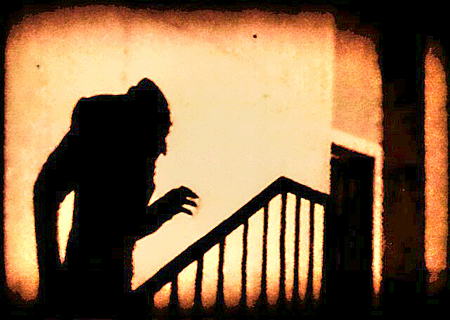 F. W. Murnau, along with the screenwriter Henrick Galeen had apparently attempted to make Nosferatu superficially different from Bram Stokers’ Dracula. However, news of this films existence reached Bram Stokers widow, Florence Stoker, who immediately pursued recompense for a clear copyright infringement. When she learned Prana Films was in bankruptcy Florence turned her attention to the media itself, demanding all copies of the film to be junked. On July 20 1925 Prana’s appeal against the films destruction was lost. The destruction of all copies of the film was set to go ahead. F. W. Murnau, along with the screenwriter Henrick Galeen had apparently attempted to make Nosferatu superficially different from Bram Stokers’ Dracula. However, news of this films existence reached Bram Stokers widow, Florence Stoker, who immediately pursued recompense for a clear copyright infringement. When she learned Prana Films was in bankruptcy Florence turned her attention to the media itself, demanding all copies of the film to be junked. On July 20 1925 Prana’s appeal against the films destruction was lost. The destruction of all copies of the film was set to go ahead.
To all intense and purpose it appeared that Nosferatu was now lost, with a metaphorical stake to the heart. But just like the vampire progeny and legacy, it escaped, maintaining celluloid immortality.
Nosferatu is available on DVD and Blu-Ray.
SHOESTRING FEATURES
Brief explorations into Independent low budget films and film making.
UFO ABDUCTION (1989) aka THE McPHERSON TAPE - AND ALIEN ABDUCTION: INCIDENT IN LAKE COUNTY (1998)
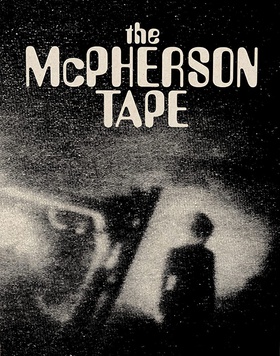 The Van Heese family celebrates their 5 year old daughter Michelle’s Birthday, in their Connecticut home on the evening of October eight 1983. During the jollity, which is being filmed on VHS video by Michael Van Heese (older brother of Michelle), the lights go out, and while trying to remedy this at the outside fuse box, three brothers, Michael, Jason and Eric witness a red light pass overhead. Tracing the direction of the light they discover a landed extra-terrestrial craft, with three small alien creatures moving around outside. The brothers are spotted and scramble frantically back to the home, where the nightmare for the Van Heese family begins. The Van Heese family celebrates their 5 year old daughter Michelle’s Birthday, in their Connecticut home on the evening of October eight 1983. During the jollity, which is being filmed on VHS video by Michael Van Heese (older brother of Michelle), the lights go out, and while trying to remedy this at the outside fuse box, three brothers, Michael, Jason and Eric witness a red light pass overhead. Tracing the direction of the light they discover a landed extra-terrestrial craft, with three small alien creatures moving around outside. The brothers are spotted and scramble frantically back to the home, where the nightmare for the Van Heese family begins.
Written, Directed and Produced by Dean Alioto with a cast of non-actors and budget of $6,500 the film is presented as, and is an early example of, found footage. The film was produced by IndiSyndicate Productions and released by Axiom Films in 1989.
Although the film has become known as the ‘McPherson Tape’, this is actually the name of the family from the 1998 remake of the story titled ‘Alien Abduction: Incident in Lake County’. This version of the story had a bigger budget and professional actors, written by Alioto and screenplay by Paul Chitlik, released in January that year.
The original film, just over an hour long, has been broadcast on US TV and was released in 2018 on DVD and on Blu-Ray in 2020. It still has a following that believe it to be actual footage of an Alien invasion. Unfortunately the original 3/4 inch tapes of the footage were apparently destroyed in a warehouse fire prior to any release of the film, leaving only the released edit, with a director’s cut of the film in 2017.
WHEN THE WIND BLOWS (1986)
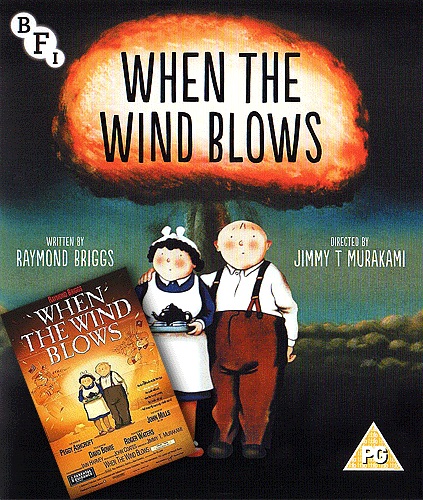
Compared to other films listed here, the budget for ‘When the Wind Blows’ is substantially higher. However £1.7 million is still a very modest amount for a fully animated feature film, even in 1986. The project was a co-production of a number of companies; Meltdown, British Screen, Film Four International, TV Cartoons and Penguin Books. ‘When the Wind Blows’ was directed by Jimmy T. Murakami, who also directed ‘The Snowman’.
The screenplay was written by the author Raymond Briggs (who also wrote ‘The Snowman’), adapted from his graphic novel of the same name. The story involves Jim (John Mills) and Hilda (Peggy Ashcroft) Bloggs, a retired couple living in the countryside. Miles away from their self-contained and apparently secure lifestyle world politics is fracturing and escalating into a superpower conflict, fast approaching its terrifying nuclear conclusion. Jim and Hilda have to try and work their way through different booklets on how to survive the looming disaster, with little more than blind faith in authority and their memories of WWII as children. After the Armageddon that follows, they stumble through the deadly emptiness of a very different and hostile environment.
The animation techniques used for ‘When the Wind Blows’ were very complex, involving both model and cell animation combined. Jim and Hilda’s home comprised of miniature model sets and the characters drawn and painted for cell animation. Compositing these elements together required a great deal of planning and work. Add to this a camera that is often moving around the sets and characters, adding further to the complexities. The end result is a novel and creative blend of animation techniques.
After its cinema release When the Wind Blows was made available on VHS, and has since been released on standard DVD in 2005 by Channel 4 for the U.K. Then in 2010 for the United States market. More recently (2018) the film was released by the BFI (British Film Institute) in a dual format DVD (standard DVD and Blu-ray DVD) package for the U.K. It has extras; including making of documentary, interviews, commentary and a booklet. In 2020 Severin Films released both Blu-ray and standard DVD versions in the United States.
John Mills (the voice of Jim Bloggs) passed on April 23 2005. Peggy Ashcroft (the voice of Hilda Bloggs) passed on June 14 1991. Both had long established careers in film and television. Raymond Briggs passed away on August 9 2022. The Director Jimmy Teruaki Murakami passed away February 16 2014.
NIGHT OF THE LIVING DEAD (1968)
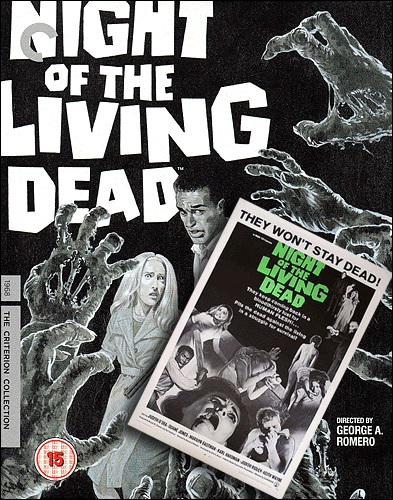 In 1968 George A. Romero inadvertently changed the shape of archetypal ‘zombie’ movies forever. Although Romero stated he had not written a ‘zombie’ story, rather a story about ‘cannibalistic, undead ghouls’. His independent film would spawn a new sub-genre of horror. The Night of the Living Dead was written, photographed and directed by Romero, and co-screen written by John A. Russo. In 1968 George A. Romero inadvertently changed the shape of archetypal ‘zombie’ movies forever. Although Romero stated he had not written a ‘zombie’ story, rather a story about ‘cannibalistic, undead ghouls’. His independent film would spawn a new sub-genre of horror. The Night of the Living Dead was written, photographed and directed by Romero, and co-screen written by John A. Russo.
The story of Night of the Living Dead is set in Pennsylvania and features seven strangers trapped in a farmhouse which is surrounded by a growing number of undead ghouls, hungry and determined to eat the flesh of the living.
Whether all zombie related movies and TV series that followed Night of the Living Dead would have come to life and crawled from the ground into the living world is open to speculation. However, it seems reasonable to say that Night of the Living Dead did in many ways lay the foundations of most zombie narratives to come.
Romero, having already made a number of short films at the time, started a production company in 1962 with friends called Latent Image producing commercials and industrial films, including TV spots for political campaigns. All those involved with Latent Image – including Romero - would direct and edit their own commercials, thus gaining experience and becoming the springboard for Romero to make this notorious independent feature.
With a budget of up to $125,000 ‘Night of the Living Dead’ has grossed up to $30,000,000 (2014).
The film starred Duane Jones (as Ben) and Judith O’Dea (as Barbra). Romero stated that Duane Jones, an African American, was picked for the lead because he was the best actor they could find to play the part. Duane Jones sadly died on 22 July 1988 from cardiac arrest. His careers included Actor, Theatre Director, Artistic Director and Teacher.
George A. (Andrew) Romero passed away on 16 July 2017 from lung cancer, just as the restored version of Night of the Living Dead was released, 50 years after the original film was shown for the first time at drive-ins and limited cinema screenings. Romero was 77 years old.
Night of the Living Dead is currently available on double discs Blu-Ray and three discs standard DVD releases from The Criterion Collection 2018. Cat. Number: CC2851BDUK. Night of the Living Dead is also available on digital from the Criterion Channel via iTunes and Amazon.
The restoration of the film for this release was supervised by George A. Romero (writer, photographer and director), John A. Russo (co-writer), Gary R. Streiner (sound engineer), and Russell W. Streiner (producer).
More information from The Criterion Collection: ‘Night of the Living Dead’; www.criterion.com/films/29331-night-of-the-living-dead
A GHOST WAITS (2020)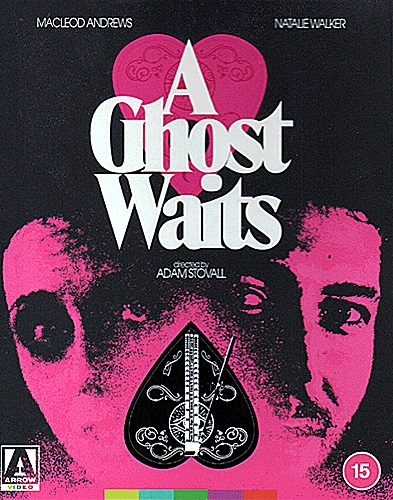
A ‘micro-budget’ mixed genre haunted rom-com drama. Written (with Matt Taylor) and Directed by Adam Stovall and featuring MaclLeod Andrews, who plays Jack, and also co-wrote the screenplay, and Natalie Walker, who plays Muriel.
‘A Ghost Waits’ was an official entry into FrightFest Glasgow, Rama Skrik, Dead And SudBuried Horrorthon, Scream Fest and Popcorn Frights Film Festivals in 2020.
Muriel haunts a house, and has successfully frightened many occupants out of the property. Jack works for the owner of the property Neal, played by Adam Stovall. Jack works as a ‘fixer upper’, employed to make sure the property is in good condition and ready for the next tenants to move in. Surprisingly he finds all the previous tenants possessions still in the house.
Very quickly strange occurrences start and Jack is confronted by Muriel in her ‘scare the crap out of them’ guise. However, over time the two develop a relationship which conflicts with what is expected of them both and a sweet heartfelt love story develops, rejecting conflicting outside influences.
This is mixed with a somewhat bureaucratic afterlife - in the vein of Beetlejuice – that dictates to Muriel what her purpose is. Circumstances and bureaucracy conspire to separate them, but they prove that love conquers all, along with death.
Although the film was shot in colour, it was released in black and white. The production took a few years to film and complete, with re-shoots over time. The result is a quirky, funny and touching film that doesn’t depend on special effects.
‘A Ghost Waits’ is available on DVD (Blu-Ray) from Arrow Video.
PRIMER (2004)
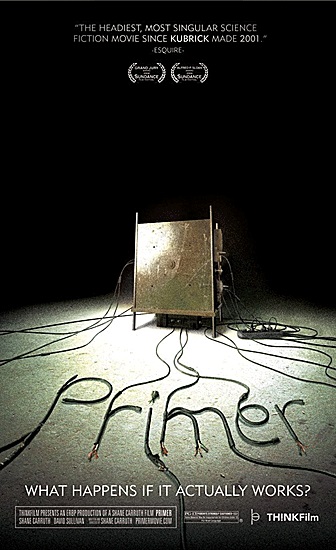
Primer is a SciFi film written, directed, produced, edited and scored by Shane Carruth who plays one of the two main leads. The film was made with a budget of $7,000, but has grossed around $842,000.
The plot and structure of the film are regarded as experimental. The film does not dumb down story line complexities, instead includes much technical language to explore the theories covered in the film.
The two main characters Aaron (Shane Carruth) and Abe (David Sullivan) accidentally discover time travel and build a time-apparatus (called 'the box') capable of transporting one human in time. Abe and Aaron initially use of the box to profit themselves through foreknowledge of stocks, but gradually notice the box has other effects on them, and eventually on their friendship. It becomes increasingly convoluted, with overlapping timelines.
Shane Carruth studied physics while writing the story/script to make the dialogue realistic. The film had a crew of five. Shane Carruth played the part of Aaron, while other cast members were made up of friends and family. Filming Primer took over five weeks and the film was shot on super 16mm. The story board for the film was made up of photographs taken on 35mm film. The limited budget meant that very few takes were shot, to save film. Post-production of the film lasted two years.
Primer and Shane Carruth received a number of awards, including Grand Jury prize at the Sundance Film Festival 2004.
Primer (2004) Official Trailer https://youtu.be/-vD-yj9o664
Primer (2004) - Trailer HD https://youtu.be/3nj5MMURCm8
Primer (2004) - Opening Scene https://youtu.be/ndHgNUuLKIM
Primer - The box https://youtu.be/2AfB1POoHZQ
DARK STAR (1970/1974)
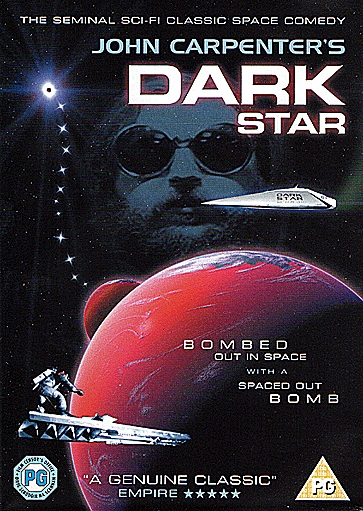
Dark Star is a SciFi comedy and became John Carpenter’s (Halloween, The Thing, They Live) commercial film debut. Carpenter also plays the voices of Commander Powell and Talby in the film. Dark Star was written by both Carpenter and Dan O’Bannon (co-creator/writer of Alien). O’Bannon co-starred in Dark Star, and also played the voices of bomb 19 and 20. O’Bannon edited the film and worked on the visual effects.
‘The Electric Dutchman’ (original title) would eventually become ‘Dark Star’ and started as a student film 1970/1972 at the University of Southern California, Dark Star was significantly reworked in order to be released as a feature film in 1974.
Initially a 16mm production intended for an hour long student movie, with a budget of $1000 from the University of Southern California (USC), growing to $6000 from other sources. Dark Star went on to have substantial cuts made, a rewrite and new 35mm footage added at the insistence of Jack H. Harris (Producer, Distributor), who had obtained the distribution rights. O’Bannon eventually remarked “We had what would have been the world’s most impressive student film and it became the world’s least impressive professional film”.
The USC claimed that film shot by students were automatically the property of the university, so John Carpenter literally ‘liberated’ the film negatives from the universities storage room. The university decided not to sue him, because they felt the film would eventually be good publicity for them.
Jack H. Harris handed over all the promotion and publicity (including making the trailer) of the film to a marketing company which turned out to belong to the mafia.
Dark Star includes a very early O’Bannon alien, which consists of a beach ball with monster gloves. However ridiculous this sounds the alien has quite a feisty personality.
The film has gained much popularity over time and garnered a cult status, partly because of the involvement of Carpenter and O’Bannon, who obviously went on to make significant names for themselves. Ron Cobb was a production designer on Dark Star and went on to work on major motion pictures, including Star Wars and Alien.
Sadly Dan O’Bannon passed away in 2009. Ron Cobb passed away in 2020.
Dark Star 1974 Trailer HD https://youtu.be/lwISbJfRNz0
Let There Be Light The Odyssey of Dark Star (long documentary, but well worth the watch) https://youtu.be/N8arhlWdTpg
UNFICTION / ARG - MYSTERIES AND ALTERNATE REALITIES
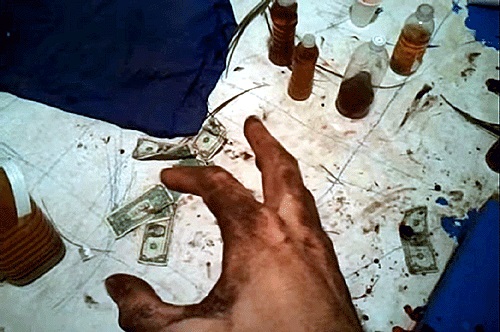 Social media platforms have given Independent Film Makers many more ways to make their films accessible for audiences. These ventures include what have become known as ARG’s (Alternate Reality Games), or Web Series, originally known as ‘unfiction’. Some use YouTube, some Twitter, others a mix of platforms to tell their stories. Social media platforms have given Independent Film Makers many more ways to make their films accessible for audiences. These ventures include what have become known as ARG’s (Alternate Reality Games), or Web Series, originally known as ‘unfiction’. Some use YouTube, some Twitter, others a mix of platforms to tell their stories.
ARG’s can be - to varying degrees - interactive. Audiences playing a part in shaping a story’s development. This interactivity can include cryptic clues, hidden links and puzzles viewers must solve to move on.
Often set in a real time world environment, audiences are participants, sometimes communicating with the protagonist and offering advice. Some have become extremely popular and gained audiences in their hundreds of thousands.
More recently some mainstream movies have promoted films through this format, to create interest in a film, and even give plot insights. ‘The Blair Witch’ (1999) was an early example, although not typically an ARG, more a device to uncover story background and exposition, using the feel and presentation of a real world event, giving the impression that the story was a factual account. One of the earliest known examples of what could be described as an ARG is ‘Ong’s Hat’ (1980’s).
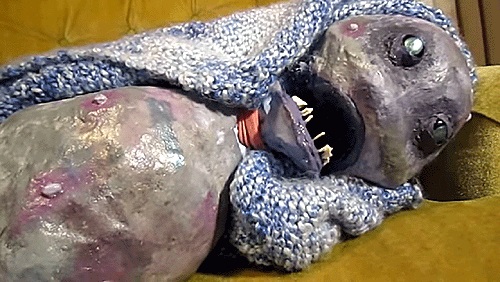
ARG’s and Web Series can range from creative episodic story telling and puzzle solving, to bulk standard sensationalism, dependent on shock value to grab attention. Some have a goal and objective, others leave any interpretation open and unclear. Which of these is most satisfying depends on the viewer.
These forms of storytelling can go beyond more orthodox methods, but use the same tropes as mainstream genres such as Mystery, paranormal and Sci-fi. ARG’s provide very effective ways for film makers to produce content with virtually no budgets, often with very little and basic equipment. Due to this new examples of ARG’s are popping up all the time.
As mentioned with Blair Witch and other early entries, ARG’s can be presented to trick viewers into believing that events portrayed could be real. Making the presentation more dramatic and shocking, like real life incidents caught on camera. ‘Ash Vlogs’ (2018/2020 - includes disturbing content) for instance is deliberately structured in this way. The outcome can be that when an audience realizes the documented events are not real, their interest in the story is peaked and fact or fiction is no longer relevant. Other entries are clearly fictional from the outset and rely on believable performances and creative storytelling to carry the audiences with them, such as ‘Daisy Brown’ (2017/2018) and ‘Hi I’m Mary Mary’ (2016/2020). These entries rely on novel presentation, not shock.
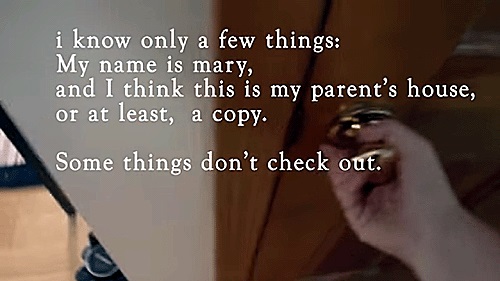 Certainly web series and ARG’s are very practical and affordable vehicles for promoting and launching independent film productions, gaining funding, and to include as part of a Film Makers CV. Certainly web series and ARG’s are very practical and affordable vehicles for promoting and launching independent film productions, gaining funding, and to include as part of a Film Makers CV.
The examples included in this brief review vary greatly in content and subject matter. They only give a taste of the genre so far.
Below are links to a few more ARG, web series not included in this feature;
‘Alan Tutorial’ (YouTube) 2011/2014
‘The Sun Vanished’ (Twitter) 2018/2020. UPDATE: The series has resumed November 12 2021.
A more detailed account of ARG; ‘Wiki’
LA PLANÈTE SAUVAGE / FANTASTIC PLANET (1973)
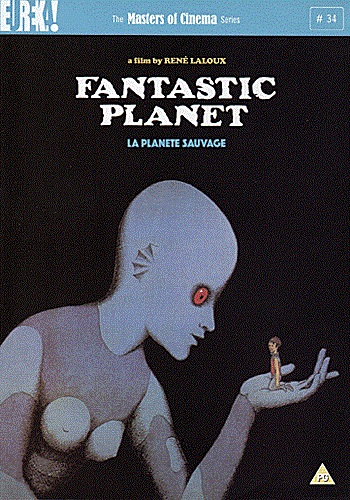 Fantastic Planet is a psychedelic dive into the surreal and nightmarish world of blue giants ‘Draags’ and tiny human-like ‘Oms’ on the planet Ygam. The Draags have kidnapped the Oms from another planet and keep them in captivity as pets. This view of the Oms as play things and toys brings with it a mix of indifference, cruel, or benevolent behavior from the Draags Fantastic Planet is a psychedelic dive into the surreal and nightmarish world of blue giants ‘Draags’ and tiny human-like ‘Oms’ on the planet Ygam. The Draags have kidnapped the Oms from another planet and keep them in captivity as pets. This view of the Oms as play things and toys brings with it a mix of indifference, cruel, or benevolent behavior from the Draags
The films narrator is an Om named Terr, and the story follows his life and eventual break out of captivity, subsequent revolt and final escape from the Draags genocidal reaction towards the rebellious Oms, now viewed as pests, and a threat.
Based on Stefan Wul’s 1957 novel Oms en série (Oms by the dozen). The animated film was the creation of René Laloux titled Le Planète sauvage (The Savage Planet), who teamed up with writer and cartoonist Roland Topor. The collaborative French-Czech co-production took five years to complete. The animation used cut-out artwork to bring the creation to life. Le Planète sauvage won the special prize at 1973 Cannes Film Festival.
The English dubbed version of the film (for the US market) was produced by Roger Corman, and the title changed to ‘Fantastic Planet’ for distribution by New World Pictures. René Laloux died on 14 March 2004, aged 74. Roland Topor died on 16 April 1997, aged 59.
For more information about this film;
Mark Kermode reviews Fantastic Planet (1973) | BFI Player https://youtu.be/NBdRQo-OaGg
Fantastic Planet (1973) trailer https://youtu.be/SgCxCZNkQ9E
Sci-Fi Classic Review: LA PLANÈTE SAUVAGE https://youtu.be/KFwHCCES1do
THE LAST BROADCAST (1998)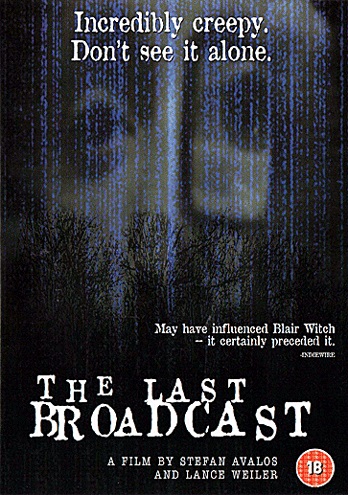
Back in 1998 Stefen Avalos and Lance Weiler released their film ‘The Last Broadcast’. Touted as the first desk-top motion picture with a budget of $900. A feature film made with consumer equipment and early affordable computer NLE (Non-Linear Editing) software. It also became the first digital film to be premièred (on the 23rd October 1998) in a cinema using video projection. The filmmakers established another first when the film was played in a number of theatres via a satellite beaming the film to multiple venues and audiences.
The film and its production was a glimpse into the future of what has become normal in low budget accessible film production. Avalos and Weiler also used the internet to market and promote the film, exploring the story online to create an interest in the story and movies release.
Unlike practically all found footage, or POV films, The Last Broadcast ends with an original and surprising narrative twist.
Two shorts (links included below) from 1998 explore the background, people and methods behind making The Last Broadcast.
Making of "The Last Broadcast" https://youtu.be/q_Kb2xtwOS8
Stefan Avalos & Lance Weiler on "The Last Broadcast" https://youtu.be/Rw_J8TsvXSY
The Filmmakers
Stefan Avalos; www.stefanavalos.com
Lance Weiler; www.lanceweiler.com
TURNING TIDE (2019)
How We Made An Epic WW2 Movie On A Low Budget | The Making of Turning Tide https://youtu.be/TlnLPMPdUk0
A detailed look behind the scenes of all aspects involved in the making of ‘Turning Tide’ (2018) Written and Directed by Andrew Muir, Produced and VFX Supervisor David Ross.
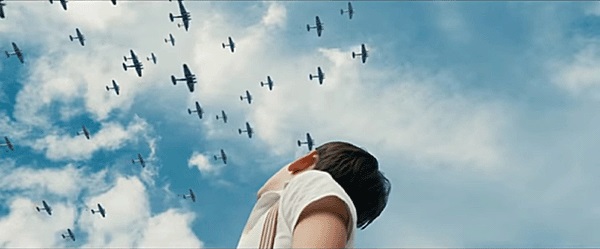
Growing up in wartime Scotland, ten-year-old David McKellar's life takes a dramatic turn when a massive German air squadron flies over his home on their way to a bombing raid. The situation rapidly escalates when they are intercepted by British Spitfires over the sea, resulting in a spectacular air battle in which one of the enemy bombers is shot from the sky.
As David watches from a nearby hillside, an injured pilot escapes from the sinking wreckage and makes it to shore, immediately going on the run. As the fugitive disappears further into the distance, the young boy must make the fateful decision on whether or not to follow... Watch the short film ‘Turning Tide’ here; https://youtu.be/6eYOZNjUqp4
IMPORTANT: A websites Inclusion here is not an endorsement of the site, or its current availability. indefilms.net accepts no liability for any damages, direct or indirect, that may arise from downloading or installing any software listed on this, or third party sites. |